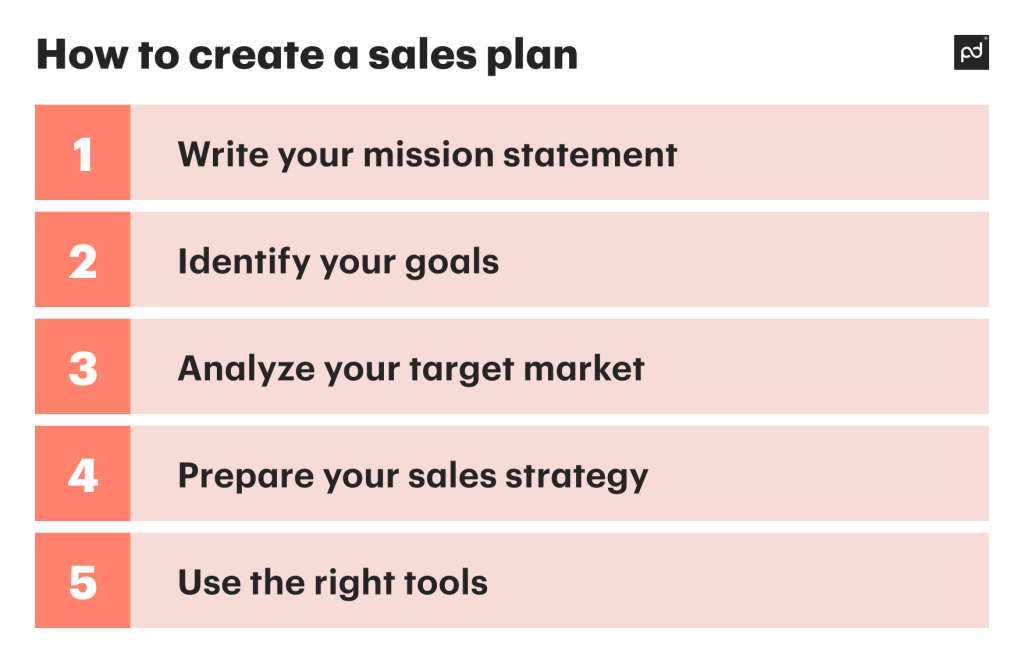A sales plan is a roadmap that outlines your business’s strategy for selling its products or services.
Acting as an essential tool for businesses of all sizes and in all industries, a robust sales plan helps to identify sales goals, target markets, and sales tactics to achieve those goals.
Without further delay, let’s take a look at how you can create an effective sales plan for your business.
What is a sales plan?
A sales plan is not dissimilar to a business plan, except that a sales plan focuses entirely on sales activities.
A sales plan contains everything your sales team needs to know about their roles and how they can influence meeting your organization’s sales targets in addition to contributing to the company as a whole.
A sales plan includes, but is not limited to:
- Analysis of your target market and buyer personas
- Month-to-month forecasts
- Specific sales strategies to attract, engage, and sell to potential customers
- Sales team roles, their specific responsibilities, and their necessary skill sets
- Potential challenges and roadblocks to sales
- Individual and team-wide, short-term, and long-term goals.
A sales plan is a customizable document that is not designed to remain static.
As your company changes and grows, your sales plan should alter to reflect the specifics of your business.
Types of sales business plan
There are several types of sales business plans that you can create, all of which can be supported by a sales or business plan template.
Your ultimate choice depends on the best approach to meet your overarching needs and goals.
Here are some of the most common types.
New product
This type of plan is specifically designed to introduce a new product into the market and achieve specific sales goals.
It includes detailed information on the product — such as its features, benefits, and unique selling proposition.
The plan also includes a timeline for product development and launch, pricing strategies, promotional campaigns, and sales targets for the first year.
Sales goals
A sales goals plan focuses on goals instead of revenue.
This type of plan may include hiring and onboarding followed by sales training plans — or plans to introduce a new method of sales activity into your existing processes.
A sales goals plan provides a clear roadmap for your sales team to follow, and helps to identify potential challenges and roadblocks that may arise along the way.
Customer segment
The customer segment sales plan is centered around identifying the target customers for a new product and creating a sales strategy to reach them.
It includes a thorough analysis of the customer segments, including their demographics, psychographics, and buying behavior.
The plan also outlines the sales channels that will be used to reach these customers — such as online marketplaces, social media, or brick-and-mortar stores.
This plan includes specific tactics for each channel, including promotional campaigns and pricing strategies that are tailored to the target customer segments.
Why is sales planning important?
To reach your company’s overall sales goals, it’s essential to implement sales planning.
Effectively planning sales and comparing reality against sales goals templates can provide indicators a sales strategy isn’t working—so you can take the necessary steps to improve it.
When sales targets are aligned with precise actions and timeframes, your team feels part of your business’s success — and ultimately more motivated to reach their sales targets.
Setting clear expectations and providing ongoing feedback and support is an efficient way to measure progress against your sales goals, identify areas for improvement, and make adjustments as needed.
The process of sales planning also helps to optimize the use of your company’s resources — including time, money, and personnel.
By identifying the most effective sales strategies and tactics, sales planning helps you allocate your resources in the most efficient way possible.
Another benefit of sales planning is that it aids the process of identifying new sales opportunities and potential customers.
By analyzing the market and customer data, sales planning enables your sales team to target specific customer segments and develop effective sales strategies.
Studying examples of sales plans can help illustrate this, so let’s look at an example sales plan excerpt now.
Target market
A company that specializes in customized software solutions for small to medium-sized businesses might create a sales plan to target businesses in major US metropolitan areas working in the technology, retail, and healthcare industries — with annual revenues of $1 million to $20 million.
Sales objectives
In this example of a sales plan, the sales objectives could be to simultaneously increase sales by 25% and to acquire 10 new customers in the first year of operation.
Sales strategies
To achieve these sales objectives, the company might attend industry trade shows and conferences to generate leads, offer free consultations to potential clients to showcase their expertise, and establish partnerships with other companies that serve their target market.
Sales metrics
Appropriate sales metrics to track would include tracking the number of leads generated per month and the conversion rate of leads into clients.
Sales team
For the sales team to work together to attain these objectives, a realistic approach would be to provide regular sales training and coaching to improve performance, as well as establishing performance goals and incentives to motivate the sales team.
3 Key elements of a sales plan
There are several elements that should be included in your sales plan, but here are three of the most important:
1. Training initiatives
The first key element of your sales plan is composed of training initiatives that provide your sales team with the skills and knowledge they need to effectively sell your company’s products or services.
This can include training on product features and benefits, sales techniques, objection handling, and customer relationship management.
By investing in training initiatives, you can work to improve sales team performance, achieve better sales results, and build a winning sales culture.
2. Realistic objectives
Your sales plan should clearly outline your chosen sales objectives and targets that you want to achieve — such as revenue targets, market share goals, or customer acquisition targets.
These objectives should be specific, measurable, and achievable, and should be tied to your overall business goals and objectives.
3. Sales tools
Specific sales tools that help you meet your sales targets can include customer relationship management (CRM) software, sales automation tools, lead generation solutions, and management tools.
In addition, consider including any other technologies that can help to streamline your existing sales process and improve efficiencies across the board.
How to create a sales plan
Okay. Now it’s time to create your sales plan.

1. Write your mission statement
Your mission statement is your WHY.
Why did you start your business? What’s your motivation?
A sales plan mission statement is a concise and compelling statement that outlines the purpose and objectives of your sales plan.
It should communicate the core values, goals, and aspirations of your sales team and set the tone for your overall sales strategy.
To begin writing your mission statement, think carefully about your core values as a business.
These can include elements like customer service, innovation, teamwork, integrity, or quality.
These values will guide your sales team in their day-to-day interactions with customers and help them stay focused on the bigger picture.
Your mission statement should also address the needs and wants of your target audience.
Identify who your ideal customer is — and their expectations of your sales team.
This will help you create a mission statement that resonates with your target audience.
Remember to regularly review and update your statement to ensure that it remains relevant and inspiring to your team.
Here’s a great example of a mission statement:
“Our mission is to provide our customers with exceptional service and innovative solutions that meet their needs and exceed their expectations. Through teamwork, integrity, and a commitment to quality, we will achieve our sales goals and become the go-to provider of (product/service) in our industry”.
2. Identify your goals
What are your sales goals for the next year?
How will you measure success?
Identifying clear and achievable sales goals will help you to set sales quotas and guide your team with clear directions.
You must have a clear understanding of your overall business goals.
This might include increasing revenue, expanding your customer base, launching a new product, or entering a new market.
Next, think about how you can determine your sales revenue target.
This should be a specific and measurable amount that you aim to achieve within a specific period of time, perhaps per quarter or year.
3. Analyze your target market
Analyzing your target market is a critical step in developing a successful business strategy.
It involves gathering and analyzing information about your potential customers, including their needs, preferences, behaviors, and characteristics.
This may involve conducting market research, analyzing sales data, and identifying trends in your industry.
Use primary and secondary research methods to gather data about your target market.
Primary research involves collecting data directly from your target audience, such as through surveys or focus groups.
Secondary research involves analyzing existing data sources, such as government reports or industry publications.
Look for patterns and trends in the data you gather, such as changes in consumer behavior, emerging technologies, or shifts in industry regulations.
This will help you identify opportunities and threats in your market.
You should also assess your current competition — check out their products, pricing, marketing strategies, and customer service.
This will help you to differentiate your business and identify areas where you can compete effectively.
For example, you may find new approaches such as how to use sales prospecting effectively to reach new target audiences.
4. Prepare your sales strategy
This section of your sales development plan should include a brief overview of your target audience’s journey with your brand — their pain points and problems, and how your sales team will work to solve their issues effectively with your business’s solution.
Your sales strategy will include activities such as digital marketing tasks on social media, email, search engine optimization (SEO), and pay-per-click (PPC) advertising.
You may also have decided to embark upon referral marketing to incentivize your existing customers to refer new customers to your business.
Go ahead and list your strategies accordingly in this area of your sales plan.
5. Use the right tools
To effectively develop a sales plan, you need the right tools for the job.
The right tools will help you write a comprehensive and effective sales plan.
Some tools you may find helpful include:
Customer Relationship Management (CRM) software
CRM software can help you track customer interactions, sales leads, and customer data.
These tools can help you understand your customers better, create targeted marketing campaigns, and improve your sales performance.
Sales forecasting tools
Sales forecasting tools can help you predict your future sales based on historical data, market trends, and other factors. Use these tools to set realistic sales goals and allocate resources accordingly.
Competitor analysis tools
Competitor analysis tools can help you research your competition, their products, and their sales strategies, as well as how to differentiate yourself from your competitors.
Marketing automation tools
Marketing automation tools can help you automate repetitive marketing tasks — like email campaigns.
Strategic sales plan template
Much like thinking about the key elements every sales proposal must have, you need a strategic sales plan template to get started.
You can also use a combined sales and marketing plan template for a unified approach.
Strategic sales plan examples include territory sales plans — in this example you divide your market into geographical regions.
You then assign sales reps to specific territories to identify key accounts within each territory, and to develop a sales strategy for each region.
Use a strategic sales planning template to list your intentions and teach your sales team how to create a sales process map to map out the sales journey.
Boost your sales team’s results with an effective sales plan
To create a sales plan that encourages the best results, consider taking the simple approach with PandaDoc’s free sales plan templates.
A PandaDoc template will help you to write a compelling and shareable sales plan.
You’ll find commonly used sales plans sections with tips that guide you in filling out your data.
By following these tips and creating an effective sales plan with PandaDoc, you can help your sales team achieve better results and drive growth for your business.
Disclaimer
PandDoc is not a law firm, or a substitute for an attorney or law firm. This page is not intended to and does not provide legal advice. Should you have legal questions on the validity of e-signatures or digital signatures and the enforceability thereof, please consult with an attorney or law firm. Use of PandaDocs services are governed by our Terms of Use and Privacy Policy.


